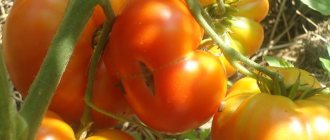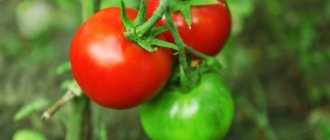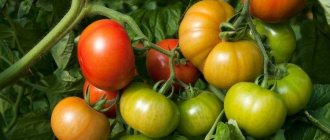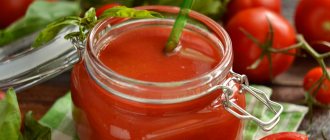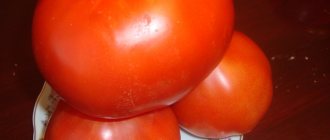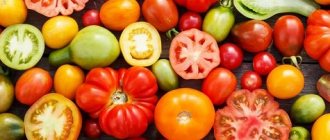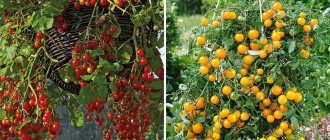The best varieties of tomatoes for open ground
When choosing tomatoes for open ground in the Moscow region, preference is given to early-ripening, low-growing or medium-growing varieties that set fruit under unfavorable weather conditions.
Low-growing tomatoes for canning
The priority requirements for pickling tomatoes are small size, smooth ripening, dense skin and pulp.
Fighter (Brawler)
Weekend gardeners will benefit from drought-resistant tomatoes that do not require special care, such as the Fighter variety, which ripens on the 95th day after germination. The standard plant reaches a height of 45 cm and does not need a garter. Cylindrical red fruits weigh from 67 to 88 g. The peculiarity of the variety is dark green, highly corrugated leaves. The fighter is little susceptible to bacterial and viral infections.
The tomato variety Fighter also has another name - Buyan
Snowdrop
All-purpose tomatoes are also popular in the Moscow region. The cold-resistant, early-ripening variety Snowdrop goes both in salads and for pickling. The determinate plant requires staking due to the heaviness of the fruit clusters. Productivity - 6 kg per 1 m2. Red fruits gain weight up to 130 g.
The tomato variety Snowdrop is one of the largest early tomatoes.
Northern baby
Stress-resistant varieties are grown in the Moscow region. The determinate variety Northern Malyutka does not suffer from either root or crown rot. The weight of red round fruits is 45–60 g. The yield is only 1.9 kg per 1 m2, but the tomatoes ripen very early.
The Northern Baby tomato variety does not suffer from root and blossom end rot.
Salad tomatoes
Although pickled tomatoes are also eaten fresh, you want a rich taste. It is possible to grow salad tomatoes in the garden if you choose varieties of early and medium ripening. They are also cultivated in greenhouses, but outside (if the weather is sunny) they will pick up more sugar, because sweetness depends on the light. Salad varieties are not necessarily large-fruited, but they are eaten fresh, since they are not suitable for preservation due to their thin skin and loose pulp.
Dad
Tomatoes, which are undemanding to soil fertility, are especially valued. The tall variety Batyanya needs staking and shaping, but the effort pays off with aromatic tomatoes. Fleshy, heart-shaped raspberry fruits weigh up to 200 g and are used fresh and for making juices.
Tomato Batyanya was bred on the basis of the Bull's Heart variety
Boni MM
Along with new ones, gardeners sow proven tomatoes that never fail. The standard salad variety Boni MM reaches a height of 50 cm and is crowned (the stem ends with a flower cluster and stops growing). Flat, slightly ribbed fruits ripen on the 83–88th day after emergence. The first inflorescence is formed above the 6–7th leaf. Fruit weight is 58–63 g with a yield of 5.5–6.5 kg per 1 m2.
Tomato Boni MM produces small, tasty, round-shaped fruits
Golden heart
Orange-fruited tomatoes will add a bright note to the salad. The early ripening variety Golden Heart ripens on the 95th day after germination. Fruit weight: 90–107 g. Diet juice is made from ripe tomatoes. The value of the variety is its yield (7 kg per 1 m2) and the increased content of beta-carotene in the fruits.
Tomato Golden Heart is an original variety bred by Yuri Ivanovich Panchev
Wonder of the earth
Hardy tomatoes have been developed that set fruit even under unfavorable conditions and temperature changes. The mid-season variety Miracle of the Earth is the record holder for yield among salad tomatoes. Although the plant is determinate, with regular potassium fertilizing, up to 13 kg of fruits are removed from 1 m2. The weight of round raspberry tomatoes reaches 380 g.
The Miracle of the Earth tomato fruit has four-lobed pulp
When I first started gardening and lived in a cold climate, the most problem-free tomatoes for growing outside were Balcony Miracle and Irishka. The last tomato, despite its tiny size, has a pleasant taste. The varieties bore fruit on sandy soil, without fertilizers.
Having gained experience, I grew more finicky large-fruited tomatoes that required additional feeding. I remember the Orange variety. The delicate, buttery sweet taste of these tomatoes has never been found in any other orange-fruited variety. The famous Persimmon, Honey Spas and De Barao yellow are not endowed with such an aroma. Orange is a mid-season variety that requires support and pinching, but is worth the effort.
Video: proven tomato varieties for open ground in the Moscow region
Low growing varieties
Many gardeners value low-growing tomato varieties, since these varieties do not produce stepchildren. Thanks to this feature, care is much easier. And a rich harvest does not cancel out the absence of stepchildren. Let's get acquainted with low-growing varieties suitable for greenhouses in the Moscow region.
Leningrad Chill
From one bush you can collect about 20 fruits: oval, red and shiny, with dense pulp. The bushes rarely reach more than 35 cm in height; 3 kg of fruit can be collected from one.
Snowdrop
An early ripening tomato with outstanding frost resistance. The bushes do not need pinching, but hilling is required. The fruits have a wonderful taste and reach 150 grams in weight.
Mirage
A tomato with fruits of universal purpose and early ripening. The harvest is well transported, so the variety is also interesting for farm cultivation. The fruits ripen together.
Barnaul Cannery
The variety is more suitable for open ground; the bushes reach forty centimeters. The fruits are elongated, deep red, and have dense, tasty pulp.
Features of growing tomatoes in the Moscow region
Tomatoes are the least capricious of the nightshade crops, so they can be grown even in the Moscow region, provided that sowing dates, temperature conditions and regular fertilizing are observed.
Home seedlings
The favorable time for sowing tomatoes lasts from early March to early April. Tall varieties are sown first, and then low-growing, early-ripening ones. Tomatoes for greenhouses are sown 2-3 weeks earlier than garden tomatoes. To calculate the sowing day, usually count 60 days from the date of intended planting of seedlings in the ground, adding a week for seed germination.
Seedlings are grown in the same way as in other regions. A week after picking, to prevent stretching, the tomatoes are fed with the root formation stimulator Atlet according to the instructions or with potassium monophosphate at the rate of 1 heaped teaspoon per bucket of water. Three feedings will be required every 7 days.
When using root formation stimulants, stocky, squat tomato bushes are formed
Planting seedlings in open ground
Growing tomatoes outdoors is more difficult than in a greenhouse due to the cold. At temperatures below +10 °C, the growth of the bushes stops, the leaves acquire a purple tint. Depending on the weather, seedlings are transplanted into open ground from mid-May to mid-June.
When the leaves turn purple, it means the tomatoes are freezing and cannot absorb phosphorus.
In the Moscow region, for growing tomatoes in open ground, high beds with loose, moisture-absorbing soil are arranged in a sunny place. At higher elevations, bushes bloom faster. A few days before sowing, the bed is covered with a transparent film until the soil warms to a temperature of 13–15o C at a depth of 15 cm.
Which tomatoes are best to plant?
Before choosing the best variety, you need to decide how the cultivation will take place (open or closed ground) and what the fruits will be used for.
Important! It is necessary to purchase zoned seeds.
Low-growing, early-ripening hybrid varieties are suitable for open beds and collapsible greenhouses. They will have time to ripen before they are affected by late blight.
When growing in permanent greenhouses, the ripening period is not given any importance. You need to focus on the height of the plant and the taste characteristics of the fruit. Indeterminate ones are suitable for such cultivation, allowing you to get a large harvest from a minimum area. When selecting varieties, it is important to focus on cultivation rules. It is recommended to grow plants that are resistant to late blight and other fungal diseases.
Treatments for diseases and pests
If dark depressed spots form on the “nose” of tomatoes every year, it means that there is not enough calcium in the soil and the plants suffer from blossom end rot. To prevent the disease, 2 weeks before the tomatoes ripen, the bushes are sprayed with a solution of calcium nitrate in a concentration of 1 heaped teaspoon per 10 liters of water.
Blossom rot is not a contagious disease, but a physiological disease that occurs due to a lack of calcium.
A common tomato disease, late blight, is caused by fungi. Since the spores overwinter in the top 10 cm of soil, in the spring the beds are shed with a solution of copper sulfate: 1 tablespoon per 10 liters of water.
With late blight, brown spots appear on the leaves and fruits of tomatoes, which turn black over time.
The first treatment of seedlings against late blight is carried out in the evening 2 weeks after planting with antifungal drugs:
- Ordan;
- Profit Gold;
- copper oxychloride.
Other fungicides against late blight are also allowed, the main thing is that the active ingredients alternate, otherwise harmful organisms will develop resistance to the chemical. Before processing, add adhesive to the bucket with the solution:
- 100 ml milk;
- 1 tablespoon sugar;
- 3-4 drops of liquid soap.
Tomatoes are sprayed every two weeks, but treatments are stopped 20 days before harvest.
When spraying tomatoes, protect your hands with gloves and your respiratory system with a mask.
Aphids on tomatoes are eliminated by treating them twice with biological preparations Actofit or Fitoverm with a break of a week. The invasion of cutworms - caterpillars that eat the insides of tomatoes, is stopped with Bitoxibacillin according to the instructions.
Caterpillars emerge from eggs laid by cutworm butterflies on the undersides of leaves.
When purchasing pest poisons, pay attention to the harm the chemical may cause to beneficial insects. For example, the popular drug Decis, which destroys aphids, is dangerous for bees if used during tomato flowering.
Harvest and storage
Tomatoes are harvested in the morning, before they get hot in the sun. Ripe tomatoes are eaten immediately or canned. Fruits at ripeness (brown) and green are ripened in a dark room at room temperature. If it is necessary to delay ripening, the tomatoes are quickly cooled to 12o C (but with further storage in the cold, the taste of the fruit will deteriorate). Picked tomatoes without cracks and stains are stored without loss of quality for 7–10 days, green ones - from 4 to 8 weeks.
Tomatoes are best stored in one layer
